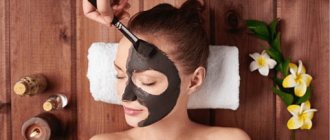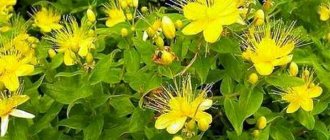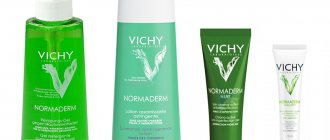Revitalizing masks for skin. Benefit. Properties
By using folk remedies to restore the skin, you can get rid of many cosmetic problems. What are their benefits?
- The vitamins included in the composition rejuvenate the dermis, smooth out wrinkles, and prevent the appearance of new ones.
- Whitening agents lighten age spots.
- Moisturizing components maintain skin hydration and resist dryness.
Based on this, we can conclude that restorative facial masks help fight the effects of vitamin deficiency in the body, moisturize dry surfaces, and slow down the aging process. Recipes for restoring the dermis include substances that provide its nutrition. By making masks just once or twice a week, you can get a wonderful anti-aging effect.
When to carry out procedures
- Masks that restore facial skin are recommended during the winter and spring periods, when there are not enough vitamins in food, which causes paleness, peeling, and redness of the surface.
- In case of dysfunction of the sebaceous glands, excessive dryness or oiliness, early signs of wilting.
- If there are signs of fatigue caused by lack of sleep, frequent stress.
Rules of application
- The skin must be cleansed of cosmetics.
- Use fresh, good quality products.
- Stir them until smooth.
- Apply immediately after preparation.
- Before use, you need to check the product for an allergic reaction. Apply a small amount of the mixture to the bend of the elbow, hold for 10-15 minutes, and observe the reaction. If no redness or irritation occurs, it can be used.
The barrier function of the skin can be disrupted in different ways. For example, as it is now, by disrupting the structure of the hydrolipid mantle by treating with organic solvents (alcohol) or surfactants, by physically destroying the stratum corneum (peeling, dermabrasion, laser resurfacing). There is another way to weaken the barrier properties of the skin - to change the composition of surface lipids, which will happen, for example, as a result of long-term restriction of dietary fat intake or prolonged use of large amounts of cosmetic oil (any kind!).
Immediately after physical damage to the stratum corneum, the rate of water evaporation from its surface increases sharply. Then over the course of several hours it gradually decreases, which indicates that the barrier layer is being restored again. If you trace the entire dynamics of restoration of the skin barrier function, you can see that at first the restoration proceeds quite quickly. In humans, the barrier function is restored by 60% after 12 hours, but complete recovery takes 72 hours. It is believed that rapid recovery occurs due to the massive release of ready-made lamellar bodies from granular keratinocytes. During the slow phase of barrier restoration, the synthesis of fatty acids, cholesterol and ceramides is increased, as well as the formation of new lamellar granules.
In response to damage to the stratum corneum, keratinocytes secrete a number of signaling molecules - cytokines, growth factors. It has been established that immediately after damage to the stratum corneum, the concentration of IL-1a (interleukin 1a), TNFα (tumor necrosis factor alpha) and some other cytokines increases. The exact role of these molecules in restoring the epidermal barrier is not yet known, but the very fact of increasing their concentration is important. Most likely, they stimulate lipid synthesis and the formation of lamellar granules in the epidermis, but they can also cause hyperpigmentation, inflammation and epidermal hyperplasia. It has been shown that even minor but systematic damage to the barrier layer (for example, frequent washing with hot water and soap) leads to epidermal hyperplasia, which suggests that cytokines produced by the skin when the stratum corneum is damaged can initiate pathological processes.
Applying various substances to the skin can help or, conversely, slow down the recovery processes.
Complete occlusion
If a plastic or rubber film is applied to the skin, the secretion of lamellar bodies and the increase in lipid synthesis does not occur. Moreover, the current problem is that occlusion itself - wearing rubber gloves - can cause damage to the barrier function of the skin, because increased humidity leads to increased skin permeability.
Apparently, an increase in the rate of water evaporation through the stratum corneum is the main signal for restoration work when barrier structures are destroyed. An impermeable film that prevents water from evaporating blocks the response of epidermal cells to damage.
Partial occlusion
If the skin with a damaged stratum corneum is covered with a layer of Vaseline, then in the first hours after the damage there is a slowdown in recovery. In electron micrographs, in the granular layer of the epidermis one can see deformed (as if eaten by a moth) lamellar bodies. This suggests that petroleum jelly to some extent penetrates into the granular layer of the epidermis and disrupts the formation of lamellar bodies. However, a thin layer of petroleum jelly does not impede gas exchange the way plastic wrap does. And a certain amount of transdermal water evaporates through it, and oxygen and carbon dioxide pass normally.
Therefore, as a result, under a layer of Vaseline, the restoration of the barrier is completed faster than without it. The temporary barrier that Vaseline creates protects the skin from severe dehydration and the penetration of toxic substances. Therefore, cells can work more successfully to restore the barrier without being distracted by the fight against external stress .
Physiological lipids
If Vaseline, when applied to the skin, penetrates only to a small extent, then physiological lipids (ceramides, neutral fats, fatty acids, cholesterol) behave completely differently. Using fluorescent labels, it was possible to show that these molecules easily overcome the stratum corneum and penetrate living cells of the epidermis. Since skin cells have all the necessary enzymes for processing exogenous lipids, lipid molecules that penetrate from the outside are quickly disassembled into “spare parts” from which epidermal lipids are built .
However, if we look at the dynamics of skin restoration, it will be clear that effective restoration of its barrier function is observed only when using a mixture of three key skin lipids - ceramides, cholesterol, fatty acids, taken in a certain ratio. During many years of experiments, it was possible to select the ratio of physiological lipids in the mixture that is optimal for the rapid restoration of the barrier - 3:1:1. Please note that this is a molar proportion , reflecting the ratio of the number of lipid molecules in the mixture and meaning that for every three molecules of one type of lipid there is one molecule of two other types. It is noteworthy that the lipid mixture should be adapted to the specific skin condition:
- if skin problems are caused by a deficiency of essential fatty acids (imbalanced diet, photodamage), then the optimal recipe for restoring the skin barrier function would be:
1 (ceramides) : 1 (cholesterol) : 3 (essential fatty acids) ;
- for aging skin, it is necessary to increase the proportion of cholesterol compared to other lipids, since in the aging epidermis there is often a violation of cholesterol metabolism, so the mixture will look like this:
1 (ceramides) : 3 (cholesterol) : 1 (essential fatty acids);
- for the treatment of atopic dermatitis and some other skin diseases, the following formulation is recommended:
3 (ceramides) : 1 (cholesterol) : 1 (fatty acids).
From a practical point of view, it is important that free fatty acids can be replaced with triglycerides or phospholipids and still obtain rapid barrier restoration. It is possible to replace ceramides with sphingomyelin or cholesterol with cholesterol esters without any harm to the repair process. This confirms the presence of very active enzymes in the skin, with the help of which epidermal cells can use exogenous lipids to synthesize their own lipids.
Rapid restoration of barrier function is observed only if three key lipids (ceramides, cholesterol, fatty acids) are present in the required ratio. It does not matter whether a concentrated or diluted lipid mixture is used, it is important that the proportion of key lipids in it is preserved.
Natural oils
Since the exclusive role of essential fatty acids in the physiology of the skin was established, natural oils have gained great popularity in cosmetology. They are often applied to the skin in its pure form. On the one hand, it would seem that the idea is good. Natural oils do not contain any extraneous chemicals, and many are rich in additional active ingredients such as phytosterols, vitamin E, and carotenoids. However, you still shouldn’t get carried away with pure oils. Let us recall that the integrity of the lipid layers of the stratum corneum is maintained by the exact ratio of all lipid components - ceramides, cholesterol, free fatty acids. Oils are neutral fats in nature, based on triglycerides. Although they can be broken down into their constituent parts to release free fatty acids, they must first penetrate lipid layers. If there is too much oil, it will dilute the lipid layers, temporarily disrupting their structure. Usually the structure of the formations is quickly restored. However, too much and frequent use of oils can lead to persistent disruption of the skin barrier function . Everything is good in moderation.
In cosmetics, natural oils are usually contained in small quantities, so they do not significantly affect the structure of the barrier.
You will find information on the composition and properties of vegetable oils used in cosmetics and skin care, as well as nuances regarding the use of physiological lipids and means for creating occlusion in our books “NEW COSMETOLOGY. Cosmetics: ingredients, formulations, application”, “Cosmetic chemistry for cosmetologists and dermatologists” and “NEW COSMETOLOGY. Fundamentals of modern cosmetology. 2nd edition, revised and expanded." They are all available in electronic form, and you can get acquainted with them today!
Revitalizing face masks: the best recipes
The best homemade revitalizing face mask
The product improves skin elasticity, tightens the oval, rejuvenates and refreshes flabby dry surface. Peel the potatoes and let them cook. When it is cooked, mash it to a puree, add warm milk, raw egg yolk, mix all ingredients well. Apply the warm contents in an even layer to problem areas, lie down and rest. After 15-20 minutes. remove everything, wash with chamomile infusion, and apply nourishing cream.
Revitalizing face mask with apple
The recipe saturates with vitamins, eliminates signs of fatigue, improves color, and refreshes appearance. Grind the apple using a grater, take one tbsp. l. mass, combine it with the same amount of homemade sour cream, mix, distribute on the skin, after 15 minutes. delete.
Revitalizing face mask with oatmeal
The product relieves the dermis from increased dryness and flaking. One tbsp. l. oatmeal pour two tbsp. l. fresh cherry juice, let stand for 20 minutes, then apply an even layer to the epidermis, leave to absorb for 15-20 minutes. Rinse with water at room temperature.
Revitalizing face mask with honey
The product perfectly tightens the epidermis, increases firmness and elasticity. Recommended for normal, dry and oily skin. Grind oatmeal (2 tbsp) with a coffee grinder to a powder, add one tsp. liquid flower honey, one egg white, mix all ingredients, carefully distribute on the surface, leave to soak for 20 minutes, after time, wash with running water at room temperature.
Revitalizing face mask with aloe
The product softens the rough, weathered surface, saturates it with useful substances, improves color, and treats burns. Grind aloe leaves, squeeze out the juice, mix with two or three drops of rose ether. Distribute the contents evenly on the skin, allow time to be absorbed, after 20 minutes. rinse with running water.
Regenerating face mask with cottage cheese
The recipe will help soften rough skin, make it soft and velvety, get rid of wrinkles, and lighten age spots. Two tbsp. l. combine fatty, homemade cottage cheese with two tsp. medium fat sour cream, mix everything well until smooth, apply an even layer to the skin of the face and neck, after 15-20 minutes. wash off.
Revitalizing face mask with avocado
The recipe restores different types of epidermis, smoothes wrinkles, gives tenderness, radiance, and velvety. Peel the ripe avocado, remove the pit, grind until puree, add two tsp. flower honey, distribute the contents on the epidermis, wait 15 minutes, then remove.
Revitalizing egg face mask
The recipe helps fight the initial signs of aging on oily skin. Separate the white from the yolk, beat the white until foamy, add one tsp. citrus juice, apply the contents to the dermis, avoiding the surface around the eyes. Remove after 20 minutes, apply nourishing cream.
From herbs
The product moisturizes, increases the elasticity of the skin, and saturates it with useful substances. Prepare a herbal mixture consisting of chamomile and sage (take two teaspoons each), pour boiling water over it, leave for about an hour. Add half tbsp. l. olive oil, stir. Gently distribute the contents onto the epidermis, lie down and rest. In 20 minutes. wash with running water.
From curdled milk
The product will improve the condition of oily dermis, narrow enlarged pores, and get rid of excessive sebaceous shine. One tbsp. l. combine yogurt with one tsp. oatmeal, and two tsp. lemon juice, stir, spread on the epidermis, wait 20 minutes.. then rinse.
From cranberries
The product tones oily skin, nourishes it with antioxidants, and activates regeneration processes. Combine cranberry juice (one tablespoon), potato starch (one teaspoon), kefir (one teaspoon), mix the ingredients well, distribute on the skin, after 15-20 minutes. delete.
Now you know how to prepare restorative face masks at home, and you can use suitable recipes.
Svetlana, for
Japanese rice masks for wrinkles
Japanese women prepare masks based on rice bran. You can purchase the product at a pharmacy or supermarket. All masks are applied using the same technology:
- the face washed with foam is dried with a towel;
- apply the mask to the entire face without rubbing, otherwise the coarse fibers of rice bran can injure the skin;
- wash off the composition after 5-10 minutes;
- For oily skin, additionally wipe the tissues with a special lotion.
The procedure can be performed while taking a bath. In this case, keep the mask on your face for 10-15 minutes.
Universal rice mask
Combine two tablespoons of bran with wheat flour and water. To get moisture from the mask, add 1.5 tablespoons of flour; for a feeling of freshness, reduce the flour to 1 tbsp. l, to eliminate oily shine, increase the amount of flour to two tablespoons.
Japanese rice mask: will lose 10 years
Moisturizing rice mask
Pour bran into a bowl and add the same amount of yogurt or kefir. Depending on the thickness, the mass is diluted with water.
Rice bran scrub
Mix one tbsp. l. yogurt and honey, add 2 tbsp. l bran. Mix everything and apply the composition to the face. Rubbing is prohibited.
Japanese mask to give your skin a luxurious look
Pour 2 tablespoons of rice bran into a bowl, add 4-6 tbsp. l. soy milk and 1/6 of a spoonful of sake sediment or 3×3 if sold by the sheet. Sake sediment can be replaced with dry white grape wine. If you want to thicken the mask, add a little wheat flour.
Regenerating agents
The following means help speed up the process of facial rejuvenation:
Cosmetic products containing nutrients - vitamins, microelements, amino acids and fatty acids - are useful for skin restoration.
Hormonal restoration complexes are suitable for women at least twenty-five years of age. Thanks to them, the skin regenerates faster, but this product must be used carefully and only under the supervision of a doctor.
Replacement components consist of keratin, collagen and elastin. Today, various oral supplements containing these substances have been created; they help the facial skin maintain its protein frame and remain elastic. A professional cosmetologist can perform procedures that promote rejuvenation and faster cell renewal. Within beauty salons, there are many programs to improve the condition of facial skin.
At home, for regeneration, the following vitamins are added to masks and taken orally:
- A - will eliminate peeling and redness, and also make the skin healthy.
- C – better production of collagen and elastin, eliminating sagging skin and wrinkles.
- E – activates the action of vitamins.
- K – improves blood circulation and promotes elastin synthesis.
Products to accelerate regeneration
Fish, especially fatty varieties, namely sardines, salmon, mackerel, herring, are rich in omega-3 fatty acids, vitamins A and D. Constant consumption of them improves blood circulation in the deep layers of the skin, restores complexion and makes it smooth.
Dairy products such as milk, cottage cheese, and cheese are no less useful. You should especially consume more cottage cheese, since the selenium and vitamin A it contains prevents aging and loss of skin elasticity. At the same time, the product has a beneficial effect on the entire body and strengthens teeth and bones.
Whole grain bread and cereals, which improve metabolism, cleanse the intestines and help remove waste and toxins from the body, are necessary to maintain regenerative functions at the proper level. Porridges work in a similar way, especially those made from buckwheat and oatmeal - the skin of the face becomes fresh when consumed regularly.
Nuts contain coenzyme Q10 and a lot of vitamin E. Being a potent antioxidant, the latter accelerates regenerative processes and does not allow toxins to destroy the body.
Don't forget about green tea, which contains a lot of antioxidants. If you drink 1-2 cups of it daily, your skin will look much better. It is especially useful to drink tea with honey and lemon.
Among fruits and berries, sour, yellow, orange and red fruits provide the greatest rejuvenating effect. These are oranges, strawberries, apricots, grapefruit, pumpkin and currants, which contain large quantities of vitamin C, which is involved in the production of collagen. Pomegranate helps wound healing, elastin and collagen production. When consumed as food, aging will slow down as it prevents the destruction of elastin and collagen.
Carrots, tomatoes, and peppers contain a lot of beta-carotene, which is responsible for intensive cell renewal. Avocado has many substances that nourish and make the skin smoother.
Olive oil is a remedy that will not allow the skin to fade, since the fatty acids and biologically active compounds in its composition help rapid tissue restoration, rejuvenation, as well as better absorption of vitamins A and E. It is also known that it contains much more vitamin B than in other oils.
Pharmacy assistants
In addition to masks, it is advisable to use other means that accelerate regeneration. These include:
- Actovegin is a drug of animal origin in the form of cream, ampoules, ointment, and gel. Oxygen enters the tissue faster through it, blood circulation is normalized.
- Dexpanthenol - softens the skin, removes flaking and red spots.
- Badyaga - its components help stimulate blood supply, smooth, cleanse and resolve inflammation.
- Essential oils, namely rose, tea tree, patchouli and petitgrain, actively regenerate the skin and also relieve it of acne, papillomas, dandruff, and fungus. Helps with insect bites, cuts and abrasions.
Before applying any product to the skin, it is necessary to test for allergies on the wrist or in the crook of the elbow.
Two lines of defense
In fact, the skin is a double defensive line of the body. First of all, it is a physical barrier - after all, the skin separates the internal environment of the body from the external one due to the epidermis. In addition, the skin is an environment where a large number of microbes live (“skin pool”), which stimulate the immune system to produce immunoglobulins, antibodies, and specialize lymphocytes (which recognize a foreign antigen and kill it - killers).
If a person is not subjected to some kind of active “attack”, aggressive influence of external factors, then the mechanical function of the skin (external protection) becomes dominant. At this time, skin cells produce mainly substances that must support their own vital functions. In this state, the epithelium is populated by normal microflora and covered with the so-called fatty acid mantle. The cells of this layer of skin are tightly adherent to each other, so the barrier is quite effective in protecting against relatively large pathogens (for example, fungi or bacteria), but is often not reliable enough in the event of a viral infection.
If the skin is damaged, macrophages, leukocytes, lymphocytes and other cells accumulate at the site of damage, which produce immunoglobulin and antibodies. They bind and absorb damaged cells, transport and remove them, protecting the damaged area from the penetration of foreign agents.
When the skin is damaged, immune reactions are formed, but the skin is different in that it is the innate, nonspecific defense mechanisms that predominate in it.
For oily skin
Yogurt mask
Ingredients:
- curdled milk – 20 g.
- oatmeal – 10 g.
- lemon pulp – 1/2 pcs.
Application.
Mix all ingredients and apply to face for 20 minutes. Rinse off first with warm water, then with cool water.
This mask also whitens and tightens the skin.
Protein-lemon mask
Ingredients:
- egg white – 1 pc.
- honey – 1 tsp.
- lemon juice – 1 tsp.
Application.
Beat the egg white, then add honey and lemon juice. Apply to face and rinse with cool water after 15-20 minutes.
What is immunity
To understand what skin immunity is and what its features are, let’s talk about how the body’s defense system works in general.
The principle of its operation is quite simple: if an antigen enters the body (foreign substances, bacteria, microbes, proteins, even the body’s own cells that have a different structure, etc.), then the body responds to this by producing antibodies. Antibodies must destroy antigens.
Already born, a person has immunity, which is called nonspecific. This includes antibodies that the child received from the mother or continues to receive through mother’s milk.
Over the course of life, the immune system “learns” to recognize more and more new antigens and responds to external threats faster and faster. This type of immunity is called specific.
The main “figures” of immunity are phagocyte cells that absorb foreign agents. Moreover (what is important) these cells destroy any “stranger” and have no specialization. Immunity is also formed due to cytokines, interleukins and other components that have a protein structure. They are involved in antigen recognition.
Specific immunity differs from innate immunity precisely in that the cells have “specialization.” The development of this immunity occurs in the thymus, or thymus gland, which is located near the throat, where inhaled air enters along with foreign microorganisms. The corresponding specific antibodies are produced against them, which are carried throughout the body by the blood stream. Lymphocytes and immunoglobulins are responsible for specific immunity. These are complex compounds consisting of carbohydrate and protein parts of the molecule.











